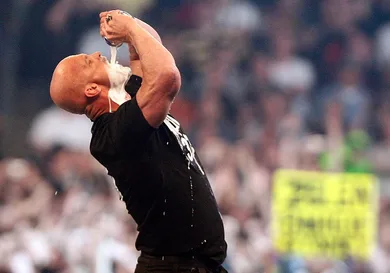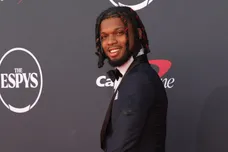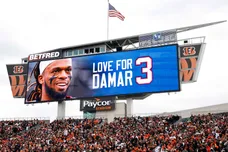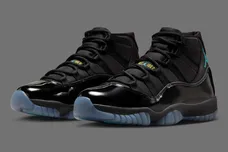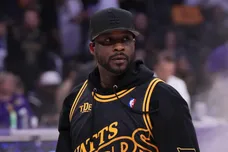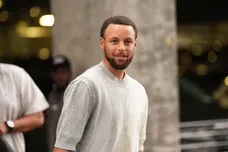Consigned to the scrapheap by WCW, Steve Williams was never meant to be the toast of the wrestling world. But through sheer grit, determination and a combative brand of charisma, he became the everyman that millions of blue-collar men and women could champion. Nearly 2 decades since he last laced up the boots, Austin remains unabashedly proud of his achievements and believes that he even surpassed the old guard’s biggest star. “I respect Hulk Hogan because his career lasted some 30 odd years,” Austin told 105.3 The Fan in 2017. “I think I lasted about 15, but during my peak years, I took the business to a height it never seen before.”
Beset by injuries, setbacks and near-misses with some career-deflating creative decisions, the real-life Steve Williams’ journey to pro-wrestling’s peak is one that harbors no shortage of twists and turns.
THE BEGINNINGS
Like many of his predecessors, Steve’s work ethic and physical endurance was formulated on the gridiron, playing Defensive End for the University Of North Texas. Awarded a free scholarship due to his footballing prowess, he renounced both academia and America’s favorite sport in favor of getting a job as a dockworker. Poised at an intersection in his life and left with no discernible direction, the Texan felt the bright lights of the Dallas Sportatorium beckon and headed for a tryout with the USWA (United States Wrestling Association). Training under the tutelage of Chris Adams, the veteran grappler quickly saw the newly christened “Stunning” Steve Austin had all the tools to be a star. “I liked him because he had already got a body," Chris affirmed. "He had long blonde hair at the time, and he looked good. And then when I gave him a try-out in the ring... he had a good feel for the business. You could just tell."
After a somewhat clunky debut against “Frogman LeBlanc," Austin—who still believed that wrestling was a legitimate sport until minutes before that first match—became a staple of the USWA’s midcard, even tangling with a young, redhaired Undertaker during his time as “The Punisher”. Little more than a year and a half after his debut, Austin made his way to Atlanta to join the rebranded World Championship Wrestling Amid spells with “The Dangerous Alliance” faction and TV title runs, but the real crown jewel in his WCW tenure came as part of “The Hollywood Blondes” tandem. Paired up with none other than the enigmatic “Flyin” Brian Pillman, the cocky young pairing eventually captured the NWA/WCW tag-team titles from Ricky Steamboat and the soon-to-be “Franchise” Shane Douglas.
Widely regarded as one of the most underrated duos in history, the combination of Pillman’s athleticism and “Stunning” Steve’s technical expertise garnered the heel duo plenty of admirers before they were abruptly disbanded by WCW’s top brass. Afterwards, Austin toiled as an auxiliary player until a knee injury sidelined him in 1995. While he was resting up, he received a Fed-Ex through the front door to inform him that he’d been let go. Believing that he wasn’t worth his weight in marketability, Eric Bischoff expanded on why he terminated Austin on the Wrestling Overrun Podcast: “I fired Steve because he was perennially injured and he had a bad attitude and he blew me off on the phone. It had nothing to do with whether or not I thought he could make money. But that made a good narrative.”
George Pimentel/Getty Images
A NEW ATTITUDE
Due to his belief that Austin would be “the biggest star in the business," fellow WCW outcast Paul Heyman leaped at the chance to bring Steve to his own private land of misfits: Extreme Championship Wrestling. Though his spell in the company was brief, Paul’s decision to let Austin air his grievances live on-air and taking all conceivable filter off would play an indispensable role in forming the attitude of the iconic “Texas Rattlesnake.”
When he first arrived in the WWE, Steve was unceremoniously stripped of his name and given the insipid title of “The Ringmaster.” Billed as a protégé of Ted Dibiase, Austin was said to “exemplify what I feel a Million Dollar Champion should be” and was handed the vanity title alongside Ted’s patented sleeper-hold. Within weeks, this gimmick was deemed to be inoperably lacklustre and Austin dejectedly returned to the drawing board. As he was channel-hopping one night, Austin would stumble upon a programme about a certain “Ice Man” that would alter the course of his life.
“I was watching a special on HBO about Richard Kuplinksi who was a serial killer, a hitman”, he told Hot Ones. “I’m not endorsing anything he did, but he was a ruthless individual so I said, there’s some traits there that could make a good villain in the squared-circle." In the midst of his pitch to the office, Austin outlined the character as “mean, cold-blooded, remorseless.” In response, the creative hivemind of WWF offered “temperature-based names” such as “Chilli McFreeze,” "Ice Dagger” and “Fang McFrost.” Then, in a story that’s been widely mythologised ever since, Austin’s then-wife implored him to drink his tea before it got “stone-cold” and wrestling’s greatest anti-hero was born.
Profane, abrasive and unrepentantly hell-raising, Steve Austin blew the doors off of the WWF’s status quo. Initially billed as an antagonist, the consumer’s weariness about the tried and tested “good guys vs bad guys” formula meant that Austin’s belligerent antics soon made him a fan favorite. Propelled up the card at a rapid rate, his coronation as one of the company’s next top stars fittingly arrived at the 1996 King Of The Ring. Upon dispatching of the new, puritanically religious incarnation of Jake “The Snake” Roberts, Austin would hop on the mic and unveil the catchphrase that would sell upwards of 10 million t-shirts:
“You sit there and you thump your Bible, and you say your prayers, and it didn’t get you anywhere. Talk about your psalms, talk about John 3:16… Austin 3:16 says I just whipped your ass!”
A spur-of-the-moment remark that would go on to encompass the character’s no-nonsense philosophy, he would soon ride the momentum all the way to a Wrestlemania 13 semi-main event submission bout against Bret “The Hitman Hart.” With his own character growing stale, this classic match would ultimately make Bret a heel, while the vision of Austin bleeding profusely but unwilling to give up until he passed out from pain cemented him as a new breed of babyface. Anointed as the company’s leading man in-waiting, it was Bret’s brother Owen that would momentarily derail the Rattlesnake’s rise to the mountaintop courtesy of a botched tombstone piledriver. In a heated contest at Summerslam 97’, the late Owen would deliver the move in an unorthodox fashion that Austin had been wary of. Just as he’d feared, this maneuver resulted in a real-life broken neck and the memory puts a chill down Austin’s spine to this day. “As soon as my head hit that mat, I was thinking Christopher Reeve," he reflected. "Cause I thought I was never gonna walk again, ever. I couldn’t feel anything from my neck down.”
THE AUSTIN ERA
Left on the injury list until November of that year, his return would coincide with a changing of the guard as Bret Hart left for WCW. “Screwed” out of the title by the villainous Vince McMahon, the emergence of the company’s chairman as their top heel provided the perfect foil for Austin’s average joe persona. Oppressed by the “the powers that be" at every turn, Steve would find himself earmarked for a WWF title opportunity against “The Heartbreak Kid” Shawn Michaels at WrestleMania 14. A year on from his emergence as their next star, Austin unleashed a hellacious stunner on the departing Michaels as special enforcer Mike Tyson counted the 1-2-3.
With the injured Shawn retreating from the spotlight, the traditional back-and-forth that follows a title change was foregone in favour of the feud between Austin and McMahon. A story that was infinitely relatable, the prospect of seeing Stone Cold finally get his hands on his malevolent boss was so inviting that their April 13, 1998, RAW IS War match enabled a creatively renewed WWF to finally score a victory over WCW for the first time in 83 weeks. As he tormented the chairman by dishing out a beer bath, filling his prized corvette with cement and causing him to urinate in front of a capacity crowd after threatening him with a prop gun, the tale would run concurrently with Austin’s hard-fought war of attrition against The Rock. After clashing over the WWF title on numerous occasions, Austin would temporarily vanquish his longtime foe at Wrestlemania XV but it’d be far from their last confrontation.
Forced to contend with the duplicitous allied powers of Vince McMahon’s Corporation and the Undertaker’s fiendish Ministry Of Darkness, Austin acted as the focal point for much of WWF’s programming in the latter stages of 90’s. Then at Survivor Series 1999, Austin would find himself on the receiving end of a "hit-and-run" in the parking lot that would take him out of action for nine months. In reality, the magnitude of a vehicular assault was a convenient way to give him ample time away to get neck surgery. Still contending with the fallout from 1997’s piledriver incident, he’d eventually return and find the assailant to be none other than The Rock’s cousin Rikishi. As expected, he beat him to a pulp and would set his sights on the Brahma Bull one year on at Wrestlemania X-7.
Then, the unthinkable happened. After years as sworn adversaries, Stone Cold and Vince McMahon stood in the ring as an alliance to a resounding chorus of boos, gazing down upon The Rock’s battered body. After capturing the WWF title once more, Austin’s career entered into one of its more maligned periods. Saddled with a noxious heel run that no-one wanted, a spell as the leader of the universally hated WCW invasion angle and embroiled in the mess that was the WWE run of the NWO, 2001-2002 were anything but the salad days of his career.
George Pimentel/Getty Images
ONE LAST RUN
Exasperated by the company and faced with the dissolution of a turbulent marriage, the news that he’d be losing a King of The Ring qualifying match to “The Next Big Thing” Brock Lesnar proved to be the straw that broke the camel’s back. In June 2002, Austin walked out. In the years that have passed, Steve has expressed remorse over how he handled the situation. “If you do want to do that match well let’s promote it, let's build it, and let’s make something of it then make some money on a Pay Per View," he reflected. "I should've went there and talked to Vince man-to-man and sell it rather than going home—it was the dumbest thing I could ever do.”
After he was slapped with a hefty $250,000 fine as punishment for his dissent, the final act of Austin’s storied career would begin in earnest. Despite conquering Hollywood and racking up numerous world title wins, the one albatross around The Rock’s neck was that he’d never defeated Austin at Wrestlemania. Upon challenging him to a match, the ailing Rattlesnake—whose injuries were now putting him in more jeopardy than ever each time he entered the ring—agreed to square off with him at WM XIX. Staring down the barrel of the end of his career, Austin was hospitalized the night before the match after a combination of stress and ephedrine-based energy drinks mimicked the symptoms of a heart attack. In grand wrestling tradition, Austin was left staring up at the lights at the end of the main event and left Safeco Field, never to wrestle another match.
Although he might have laced up the boots again, Austin still makes sporadic appearances as an on-screen personality and the response to the sound of his iconic entrance music has refused to dissipate over time. Among the most recognizable names that the business has ever spawned, Stone Cold Steve Austin has superseded wrestling and is regarded as a working-class folk hero for people all around the world. And that’s the bottom line.
